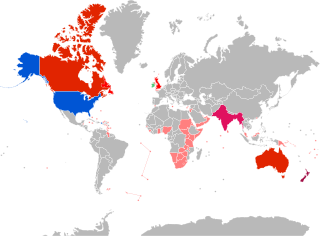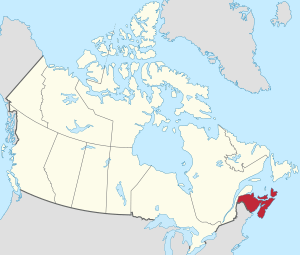War Plan Red facts for kids
Quick facts for kids War Plan Red |
|||||||
|---|---|---|---|---|---|---|---|
 War Plan Red was a U.S. what-if plan for a war with the British Empire. "Blue" meant the United States, while "Red" meant the British Empire. Different shades of red showed British territories: Britain (Red), Newfoundland (Red), Canada (Crimson), India (Ruby), Australia (Scarlet), New Zealand (Garnet). Other pink areas were not part of the plan. The Irish Free State, which was independent but still part of the British Empire, was called "Emerald" in green. |
|||||||
|
|||||||
| Belligerents | |||||||
|
|||||||
| Commanders and leaders | |||||||
War Plan Red, also known as the Atlantic Strategic War Plan, was a secret "what-if" plan made by the United States Department of War. It was one of many color-coded war plans created between 1919 and 1939. These plans helped military officers practice how to prepare for a war.
War Plan Red imagined a war with the British Empire, which was called "Red" in the plan. This name likely came from the Red Ensign flag. The plan focused on how the U.S. would defend itself if British forces tried to invade. It also thought about fighting both Japan and Great Britain at the same time.
The plan was developed after a meeting in 1927 called the Geneva Naval Conference. It was approved in 1930 by the Secretary of War and the Secretary of the Navy, and updated a few years later. It was just a practice exercise. It did not need approval from the President or Congress, because only Congress can declare war.
In 1939, when World War II began, the U.S. decided not to work on War Plan Red anymore. The plan was kept secret until 1974.
The plan described what the U.S. would do if it went to war with Britain. It assumed that the British Royal Navy would be very strong at first. It also thought Britain might use its base in Canada to attack the U.S. The plan suggested the U.S. would first fight defensively. Then, it would try to defeat the British by blocking Canada's ports and cutting off its food. Some people wonder if this plan would have worked, or if it would have ended in a tie.
Contents
What Was War Plan Red About?

War Plan Red first looked at Canada's land, military, and ways to travel. It then thought about how the U.S. could attack Canada first. The goal was to take over key ports and railways. This would happen before British troops could help the Canadians. The idea was to stop Britain from using Canada's resources, ports, or airbases.
A main step was a joint attack by the U.S. Army and Navy. They would try to capture Halifax, a port city. This would cut off Canadians from their British allies. Their next goal was to "seize Canadian Power Plants near Niagara Falls."
After that, a big invasion would happen from three directions:
- From Vermont to take Montreal and Quebec.
- From North Dakota to take over the railway hub at Winnipeg.
- From the Midwest to capture important nickel mines in Ontario.
At the same time, the U.S. Navy would take control of the Great Lakes. They would also block Canada's ports on the Atlantic and Pacific oceans.
Key Areas for Attack
The plan talked about several main areas for military actions:
- Nova Scotia and New Brunswick:
- The first attack would use poison gas against Halifax. This was to stop the Royal Navy from using the naval base. It would also cut the undersea cable, breaking the link between Britain and Canada.
- The plan looked at different ways to attack by land and sea. It decided that landing at St. Margarets Bay was better than a direct land attack.
- If Halifax could not be taken, the U.S. could take New Brunswick by land. This would cut off Nova Scotia from the rest of Canada at Moncton.
- Quebec and the Saint Lawrence River Valley:
- Taking Montreal and Quebec City would cut off the rest of Canada from the Eastern seaboard. This would stop troops and supplies from moving.
- Routes from northern New York to Montreal and from Vermont to Quebec were good for an attack. Quebec was seen as the more important target.
- Ontario and the Great Lakes Area:
- Taking this region would mean controlling Toronto and most of Canada's factories. This would stop Britain and Canada from using them to attack the U.S. industrial heartland in the Midwest.
- The plan suggested attacks from Buffalo across the Niagara River. Also, from Detroit across the Detroit River into Windsor. And from Sault Ste. Marie across the St. Mary's River into Sudbury. Controlling the Great Lakes was needed for U.S. transport during the invasion.
- Winnipeg:
- Winnipeg was a key point in Canada's railway system. It connected the country.
- The plan saw no big problems for an attack from Grand Forks, North Dakota, to Winnipeg.
- Vancouver and Victoria, British Columbia:
- Vancouver was far from Europe, making it less important. But taking it would stop Britain from having a naval base there. It would also cut Canada off from the Pacific Ocean.
- Vancouver could be easily attacked by land from Bellingham, Washington. Vancouver Island could be attacked by sea from Port Angeles, Washington.
- The port of Prince Rupert had a railway link to Canada. But a naval blockade would be easy if Vancouver was taken.
Focus on North America
Unlike other plans, War Plan Red did not plan to attack places outside North America first. Its authors believed that taking Canada was the best way to attack Britain. They thought this would make London want to make peace.
One problem with the plan was that it didn't say how to attack Britain if Canada decided to stay neutral. The authors thought Canada might do this. The plan advised against accepting Canada's neutrality unless the U.S. could still use Canadian ports and some land until the war ended.
The U.S. decided to focus on North America and the Atlantic Ocean first. It would leave its Pacific outposts like the Philippines, Guam, and American Samoa to defend themselves against any attacks from Britain, Australia, or New Zealand early in the war.
After many war games, the plan decided not to attack British ships or try to destroy the British fleet. Instead, the main American fleet would stay in the western North Atlantic. It would block traffic between Britain and Canada. The Navy would wait for a good chance to fight the British fleet. If successful, it would then attack British trade and colonies in the Western Hemisphere.
In 1935, War Plan Red was updated. It even said which roads to use for the invasion. For example, "The best practical route to Vancouver is via Route 99."
American planners did not intend to give back any British land they captured. They planned to make the captured Canadian areas into U.S. states or territories after the war. They also worried that if they lost the war, America might have to give up its own territories. For example, they feared losing Alaska to Canada as part of a peace treaty.
British Ideas for War with the U.S.
The British military never made a formal plan for war with the United States in the early 1900s. For example, in 1919, the government stopped the Royal Navy from building more ships to compete with the U.S. Navy. This prevented a plan from being made.
Most British military officers, like their American counterparts, believed that working with the U.S. was the best way to keep world peace. They shared culture, language, and goals. However, they worried that trying to control trade during a war with another nation might force a war with America.
The British military generally thought that if war happened, they could send troops to Canada if asked. But they also saw it as impossible to defend Canada against the much larger United States. So, they did not plan to send much help. They believed losing Canada would not be deadly for Britain. An October 1919 memo from the British Admiralty said that if they sent British troops to Canada, it would lead to a huge land war against the U.S. The U.S. would have all the advantages of time, distance, and supplies.
A full invasion of the United States was not realistic. A naval blockade would be too slow. The Royal Navy could not just wait for the American fleet to cross the Atlantic. This was because British trade would be too open to attack. Royal Navy officers believed Britain was weak to a supply blockade. They thought if a larger American fleet appeared near the British Isles, the Isles might quickly surrender.
Instead, the officers planned to attack the American fleet from a base in the Western Hemisphere, likely Bermuda. Other ships based in Canada and the West Indies would attack American shipping and protect British trade. The British would also bomb coastal bases and make small attacks from the sea. India and Australia would help capture Manila. This would stop American attacks on British trade in Asia and maybe a takeover of Hong Kong. The officers hoped these actions would lead to a stalemate. This would make the war unpopular in the United States, followed by a peace agreement.
A Canadian military officer, Lieutenant Colonel James "Buster" Sutherland Brown, made an earlier plan similar to War Plan Red. It was called Defence Scheme No. 1, created in 1921. He believed that "the best defense is a good offense." "Buster" Brown planned for quick attacks to take over Seattle, Great Falls, Minneapolis, and Albany. He knew they probably couldn't hold these places. The real idea was to make American troops go to the sides of the fight, away from Canada. This would hopefully give enough time for British and Commonwealth allies to arrive with more soldiers. Defence Scheme No. 1 was stopped in 1928, two years before War Plan Red was approved.
See also
- War of 1812
- Aroostook War (1838–1839)
- Pig War (1859)
- Trent Affair (1861)
- Chesapeake Affair (1863)
- Fenian raids (1866-71)
- Fort Whoop-Up (1869-74)
- Annexation Bill of 1866

